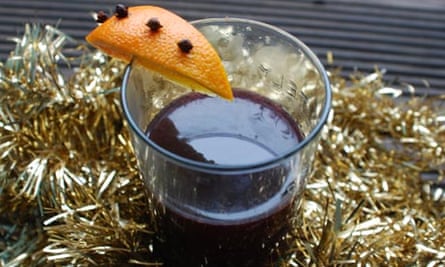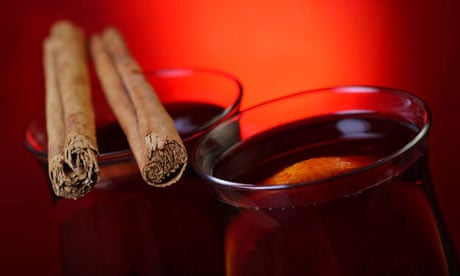On the first day of Christmas – well, December – I found myself waiting at an unusually fragrant bar. "Ooh, mulled wine!" said my friend, "brilliant!" And lo, despite having arrived with the intention of sinking a cold, dry gin and tonic, I ended up clutching a plastic cup of warm sweet wine. Such is the time of year.
Despite its high sugar content, mulled wine is not a drink that's aged well. The thin, oddly sour broth on tap at most pubs during the festive season is a sad comedown for a tipple originally designed to show off the wealth and generosity of a medieval household. Mulling is not just an excuse to serve laughably cheap wine to your unfortunate guests, although it does have that as a fringe benefit – there's a real art to it.
Medieval tipple
Given the drink's origins, I decide to start with a recipe from The Forme of Cury, a cookery book published about 1390, which starts, promisingly: "Pur fait Ypocras …" I must grind together cinnamon, ginger, galangal, cloves, long pepper, nutmeg, marjoram, cardamom and grains of paradise – although sadly I'm unable to lay my hands on any "spykenard de Spayn". A historical site helpfully suggests substituting rosemary for this aromatic Indian root, so I stick a bit of that into the pestle and mortar as well. Further than this, the recipe is coy, so I tip in some cheap French red, on the vague basis that wine was probably pretty rubbish in those days, and a suitably parsimonious amount of sugar, and taste. The mishmash of spice is overpowering – it tastes like something that might have been used to ward off the plague, rather than to make merry with during the cold, candle-lit evenings of the 14th century.
Mrs Beeton
Jumping forward five centuries, I turn to Mrs Beeton, Delia's Victorian great-grandmother, for advice. She's also pretty vague ("in making preparations like the above, it is very difficult to give the exact proportions of ingredients like sugar and spice, as what quantity might suit one person would be to another quite distasteful" she explains, helpfully), but at least the list of ingredients is more manageable: cloves, grated nutmeg, cinnamon, wine and sugar.
Thing have moved forward in 500 years; rather than just sticking everything into ye pan and hoping for the best, this recipe starts with a mulled tea. I simmer the spices together in 235ml water, "until the flavour is extracted", and then add a pint of wine, and some sugar to taste, and bring it all to the boil. The result? Classic mulled wine – not particularly exciting, but palatable enough, despite the inclusion of water, which has no place in a wine-based punch.
Delia
Delia's own recipe is an old favourite of mine: heat a couple of bottles of wine with 6 tbsp honey, an orange studded with cloves, a few slices of orange and lemon, some ground ginger and a cinnamon stick, and allow to simmer gently for 20 minutes before serving. The citrus works brilliantly with the warm spices to create a kind of winter sangria effect which never fails to please, particularly if one takes her up on the optional 2 tbsp of Grand Marnier, and then adds a few more for good measure.
Jamie
Time marches on, however, and since I first pledged allegiance to Delia and her Bulgarian Cabernet Sauvignon, there have been developments in the world of mulled wine – as seen in Jamie Oliver's "Christmas in a glass". Unlike Delia, with her pleasingly simple one-step method, Jamie's recipe kicks off with a syrup base, made by putting the sugar in a large pan along with some clementine juice and peel, lemon and lime peel, cloves, cinnamon, cardamom, bay leaves, nutmeg and vanilla, and then pouring in enough red wine to just cover it all. This is then gently heated until the sugar has dissolved, at which point the cook merrily cranks the heat up and keeps the mixture at a rolling boil until it becomes a thick syrup.
"The reason I'm doing this first," Jamie explains, "is to create a wonderful flavour base by really getting the sugar and spices to infuse and blend well with the wine. It's important to do make a syrup base first," he continues, "because it needs to be quite hot, and if you do this with both bottles of wine in there you'll burn off the alcohol." And no one wants that, do they?
Once the syrup is ready, you can pour in the rest of the wine and a couple of star anise, heat through, and serve. Although I think he's been a bit heavy-handed with the sugar and citrus peel, the flavours seem better blended, and mellower than I'm used to – and, it strikes me, it would be easy enough to make a batch of syrup in advance, and then dispense as required throughout the mulled wine season, in the manner of a well-prepared paragon of domesticity.
Glögg
As in so many things, anything we can do the Scandinavians can do better – and despite its faintly unappetising name, their take on mulled wine, glögg, somehow conjures up visions of cosy firesides and log cabins, rather than plastic beakers and sticky pub carpets. Unlike the glühwein sold at kitschy German markets up and down the UK, which is strikingly similar to our homegrown stuff but twice the price, glögg has its own, rather fearsome reputation, largely thanks to the strong spirits which lace most versions.
Cocktail king Dale deGroff, "widely acknowledged to be the world's greatest living bartender", according to his book The Craft of the Cocktail, takes his recipe from Los Angeles' Scandia club, whose members included Marilyn Monroe, Marlene Dietrich and Gary Cooper, so what it lacks in authenticity, it makes up for in celebrity provenance. I pour a bottle of red into a large pan along with raisins, flaked almonds, cardamom pods, cloves, cinnamon and orange peel and leave it to stand for 24 hours before warming gently, adding sugar to taste, and finishing off with a generous amount of vodka. I'm not too keen on the vodka, or the soggy almonds, and the lengthy infusing time has given the glögg an unmistakable hint of cough syrup. Still, those starlets will drink anything.
Festive flavours
Jamie is characteristically casual on the exact details of his recipe, urging his readers to "feel free" to add their own favourite spices to the pot too. I, however, take the liberty of removing the vanilla pod, which works in tandem with the sugar to make the whole thing rather sickly, before adding cardamom pods, in a nod to the 14th-century recipe. A dash of ginger wine gives the whole thing a kick of spice – although you could substitute a pinch of ground ginger instead if you don't keep a bottle handy for medicinal purposes.
Although I like the idea of using honey, I find it has a rather assertive flavour which clashes with the wine itself, as does soft brown sugar – plain white caster sugar is the best option here I'm afraid.
Serve this with a proper garnish, and a dose of festive cheer, and you'll find it warms the cockles of even the sourest Scrooge this Christmas.
Perfect mulled wine

Makes about 12 servings
2 unwaxed oranges
1 lemon, peel only
150g caster sugar
5 cloves, plus extra for garnish
5 cardamom pods, bruised
1 cinnamon stick
A pinch of freshly grated nutmeg
2 bottles of fruity, unoaked red wine
150ml ginger wine
1. Peel and juice 1 orange, and add to a large saucepan along with the lemon peel, sugar and spices. Add enough wine to just cover the sugar, and heat gently until the sugar has dissolved, stirring occasionally. Bring to the boil and cook for 5 – 8 minutes until you have a thick syrup.
2. Meanwhile, if you're serving the mulled wine immediately, stud the second orange with 6 vertical lines of cloves, and then cut into segments to use as a garnish.
3. Turn the heat down, and pour the rest of the wine into the saucepan, along with the ginger wine. Gently heat through and serve with the orange segments as a garnish. Alternatively, you can allow the syrup to cool, and pour it into sterilised bottles for use at a later date.
Is mulled wine a guaranteed spirit raiser, or by far the worst thing about Christmas - Slade and paper hats included? What do you put in your own festive punch – or what would you prefer to be offered instead?

Comments (…)
Sign in or create your Guardian account to join the discussion